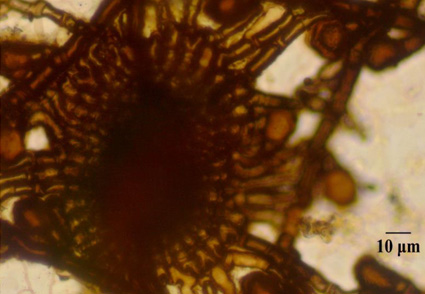Abstract
A new species of black mildew fungi was discovered infecting leaves of Ixora brachiata (Rubiaceae). The new species is described as Amazonia brachiata and it is the first record of an Amazonia species on I. brachiata. It is documented in detail with description, line drawings and photo plate, and is morphologically compared to similar species previously reported on the host family. A key to Amazonia species found on Rubiaceae is included to aid in their identification.
References
Cooke, T. (1958) The Flora of the Presidency of Bombay. Botanical Survey of India. Vol. II.
Dugan, F.M., Glawe, D.A., Attanayake, R.N. & Chen, W. (2009) The importance of reporting new host-fungus records for ornamental and regional crops. Plant Health Progress 10 (1): 34–44. https://doi.org/10.1094/PHP-2009-0512-01-RV
Hansford, C.G. (1961) The Meliolineae. A monograph. Sydowia 2: 1–806.
Hongsanan, S., Tian, Q., Peršoh, D., Zeng, X.Y., Hyde, K.D., Chomnunti, P., Boonmee, S., Bahkali, A.H. & Wen, T.C. (2015) Meliolales. Fungal Diversity 74 (1): 91–141. https://doi.org/10.1007/s13225-015-0344-7
Hosagoudar, V.B. (2008) Meliolales of India. Vol. II. Botanical Survey of India, Calcutta, 390 pp.
Hosagoudar, V.B. & Archana, G.R. (2009) Host range of meliolaceous fungi in India. Journal of Threatened Taxa 1 (5): 269–282.
Hosagoudar, V.B. & Kapoor, J.N. (1985) New technique of mounting meliolaceous fungi. Indian Phytopathology 38: 548–549.
Hosagoudar, V.B. & Riju, M.C. (2013) Foliicolous fungi of Silent Valley National Park, Kerala, India. Journal of Threatened Taxa 5 (3): 3701–3788. https://doi.org/10.11609/jott.o3302.01-88
Hyde, K.D., Norphanphoun, C., Maharachchikumbura, S.S.N., Bhat, D.J., Jones, E.B.G., Bundhun, D., Chen, Y.J., Bao, D.F., Boonmee, S., Calabon, M.S., Chethana, K.W.T. & Dai, D.Q. (2020) Refined families of Sordariomycetes. Mycosphere 11 (1): 305–1059. https://doi.org/10.5943/mycosphere/11/1/7
Index Fungorum (2021) Available from: http://www.indexfungorum.org/names/names.asp (accessed 21 October 2021)
Maharachchikumbura, S.S., Hyde, K.D., Jones, E.B.G., McKenzie, E.H.C., Huang, S.K., Abdel-Wahab, M.A., Daranagama, D.A., Dayarathne, M., D’souza, M.J., Goonasekara, I.D., Hongsanan, S., Jayawardena, R.S., Kirk, P.M., Konta, S., Liu, J.K., Liu, Z.Y., Norphanphoun, C., Pang, K.L., Perera, R.H., Senanayake, I.C., Shang, Q., Shenoy, B.D., Xiao, Y.P., Bahkali, A.H., Kang, J.C., Somrothipol, S., Suetrong, S., Wen, T.C. & Xu, J.C. (2015) Towards a natural classification and backbone tree for Sordariomycetes. Fungal Diversity 72 (1): 199–301. https://doi.org/10.1007/s13225-015-0331-z
Mibey, R.K. & Hawksworth, D.L. (1997) Meliolaceae and Asterinaceae of the Shimba Hills, Kenya. Mycological Papers 174: 1–108.
Mouly, A., Razafimandimbison, S.G., Florence, J., Jeremie, J. & Bremer, B. (2009) Paraphyly of Ixora and new tribal delimitation of ixoreae (Rubiaceae): inference from combined chloroplast (RPS16, RBCL, AND TRNT–F) sequence data. Annals of the Missouri Botanical Garden 96 (1): 146–160. https://doi.org/10.3417/2006194
Mycobank (2021) Available from: https://www.mycobank.org/page/Basic%20names%20search (accessed 21 October 2021)
Sydow, H. & Sydow, P. (1917) Beitrag zur kenntuis der Pizflora der Philippinen–Inseln. Annales Mycologici 15 (1–6): 165–268.
Theissen, F. (1913) Uber einige Mikrothyriaceen. Annales Mycologici 11: 493–511.
Dugan, F.M., Glawe, D.A., Attanayake, R.N. & Chen, W. (2009) The importance of reporting new host-fungus records for ornamental and regional crops. Plant Health Progress 10 (1): 34–44. https://doi.org/10.1094/PHP-2009-0512-01-RV
Hansford, C.G. (1961) The Meliolineae. A monograph. Sydowia 2: 1–806.
Hongsanan, S., Tian, Q., Peršoh, D., Zeng, X.Y., Hyde, K.D., Chomnunti, P., Boonmee, S., Bahkali, A.H. & Wen, T.C. (2015) Meliolales. Fungal Diversity 74 (1): 91–141. https://doi.org/10.1007/s13225-015-0344-7
Hosagoudar, V.B. (2008) Meliolales of India. Vol. II. Botanical Survey of India, Calcutta, 390 pp.
Hosagoudar, V.B. & Archana, G.R. (2009) Host range of meliolaceous fungi in India. Journal of Threatened Taxa 1 (5): 269–282.
Hosagoudar, V.B. & Kapoor, J.N. (1985) New technique of mounting meliolaceous fungi. Indian Phytopathology 38: 548–549.
Hosagoudar, V.B. & Riju, M.C. (2013) Foliicolous fungi of Silent Valley National Park, Kerala, India. Journal of Threatened Taxa 5 (3): 3701–3788. https://doi.org/10.11609/jott.o3302.01-88
Hyde, K.D., Norphanphoun, C., Maharachchikumbura, S.S.N., Bhat, D.J., Jones, E.B.G., Bundhun, D., Chen, Y.J., Bao, D.F., Boonmee, S., Calabon, M.S., Chethana, K.W.T. & Dai, D.Q. (2020) Refined families of Sordariomycetes. Mycosphere 11 (1): 305–1059. https://doi.org/10.5943/mycosphere/11/1/7
Index Fungorum (2021) Available from: http://www.indexfungorum.org/names/names.asp (accessed 21 October 2021)
Maharachchikumbura, S.S., Hyde, K.D., Jones, E.B.G., McKenzie, E.H.C., Huang, S.K., Abdel-Wahab, M.A., Daranagama, D.A., Dayarathne, M., D’souza, M.J., Goonasekara, I.D., Hongsanan, S., Jayawardena, R.S., Kirk, P.M., Konta, S., Liu, J.K., Liu, Z.Y., Norphanphoun, C., Pang, K.L., Perera, R.H., Senanayake, I.C., Shang, Q., Shenoy, B.D., Xiao, Y.P., Bahkali, A.H., Kang, J.C., Somrothipol, S., Suetrong, S., Wen, T.C. & Xu, J.C. (2015) Towards a natural classification and backbone tree for Sordariomycetes. Fungal Diversity 72 (1): 199–301. https://doi.org/10.1007/s13225-015-0331-z
Mibey, R.K. & Hawksworth, D.L. (1997) Meliolaceae and Asterinaceae of the Shimba Hills, Kenya. Mycological Papers 174: 1–108.
Mouly, A., Razafimandimbison, S.G., Florence, J., Jeremie, J. & Bremer, B. (2009) Paraphyly of Ixora and new tribal delimitation of ixoreae (Rubiaceae): inference from combined chloroplast (RPS16, RBCL, AND TRNT–F) sequence data. Annals of the Missouri Botanical Garden 96 (1): 146–160. https://doi.org/10.3417/2006194
Mycobank (2021) Available from: https://www.mycobank.org/page/Basic%20names%20search (accessed 21 October 2021)
Sydow, H. & Sydow, P. (1917) Beitrag zur kenntuis der Pizflora der Philippinen–Inseln. Annales Mycologici 15 (1–6): 165–268.
Theissen, F. (1913) Uber einige Mikrothyriaceen. Annales Mycologici 11: 493–511.


